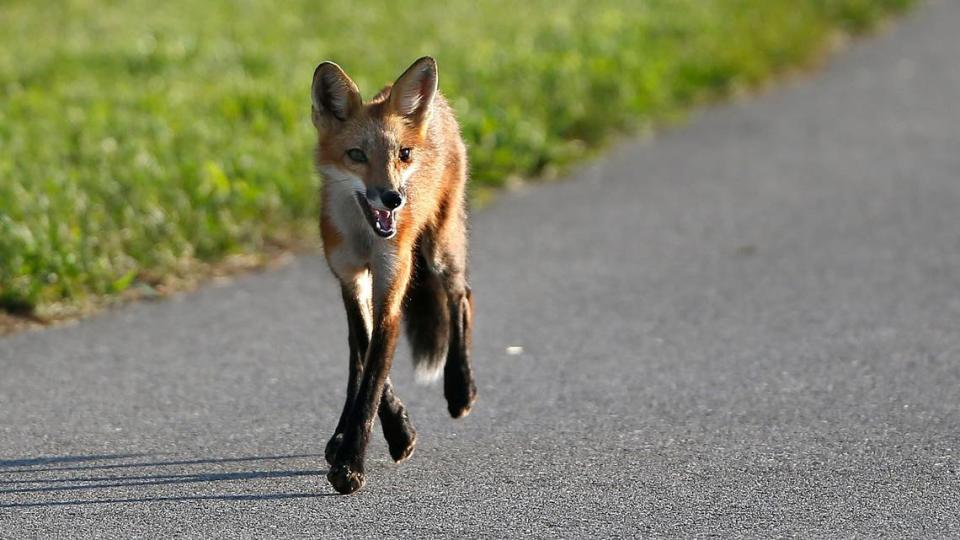Researchers want to know where foxes and coyotes are roaming Wichita. How you can help
Have you spotted a coyote or a red fox in Wichita recently? If so, the Kansas Department of Wildlife and Parks wants to know.
The Wichita Urban Coyote and Fox project, which launched March 1 in partnership with Utah State University, has the goal of measuring coyotes and fox populations in the area. The department is asking anyone who spots one of the two species to report it so it can use the data for the survey.
“We don’t really have much data and information on our coyotes and red fox populations in the city of Wichita,” said Jon Beckmann, Region 3 wildlife supervisor with the Kansas Department of Wildlife and Parks. “We know we have them here. We know that we get calls on them, but we really don’t have a lot of data, which makes it a little more difficult to manage a population.”
He said while there has been a recent uptick in reported sightings, it’s unclear whether things like security cameras are contributing.
The project will study how coyotes and red foxes coexist with humans in the city and in what areas each species is prevalent. Wildlife officials hope to find information on movements, demographics, feeding behavior, social dynamics and more, according to the website.
“Some wildlife can survive and even thrive in cities,” the project’s page reads. “Coyotes and red foxes are two such canids that are able to take advantage of the perks of the city ... However, we know very little about how these canids are successful at living among humans in the Great Plains. This lack of data impedes management.”
Here’s what to know about the two species, plus what to do if you see one of the critters in your yard.

What to know about coyotes, foxes
While coyotes and red foxes appear in all 105 Kansas counties, coyotes are likely the only one native in the state.
“They’ll use wood lots, they use grassland areas, they use [Conservation Reserve Program] fields, they’ll use agricultural fields, so you’ll find them pretty much anywhere,” Beckmann said of where coyotes can be spotted.
As for foxes, populations are commonly from Northern Canada and the northwest part of North America, Beckmann said.
“They probably were from introductions in the 17 and 1800s for fox hunting,” he said.
Coyotes tend to stay in and defend a specific territory, Beckmann said, which can range from 2 to 10 square miles. They protect the territory, usually with a mate.
Both species mate in February and March, and become more visible in April and May when their pups are born, because they are out scavenging for more food.
“It doesn’t mean anythings wrong with the animals, they’re just working hard to provide for their offspring,” Beckmann said.
Both species eat a “little bit of everything,” which can range from mice and rabbits, to seeds and leaves. Most coyotes in Kansas are in the 25- to 30-pound range, Beckmann said, while foxes typically range from 10 to 12 pounds.
Coyotes can be identified by their slender muzzle, pointed ears, coarse gray hair and bushy tail, according to the Urban Coyote Research Project. Most coyotes have yellow eyes.
Red foxes, meanwhile, have long snouts and red fur, while their stomachs, throats and chins are gray/white, according to the National Wildlife Federation.

What to do if you see a fox or coyote in your yard
Beckmann said if you see a fox or coyote in your yard, don’t be concerned.
“The mere presence of a coyote or a red fox is not a reason for concern,” Beckmann said. “Those are just animals doing what they do in a lot of cases.”
If you do see one, do not feed them.
“Most human wildlife conflicts arise because of the intentional or unintentional feeding of wildlife,” Beckmann said. “Intentional feeding, where people are throwing food out to them, but unintentional feeding could occur if people leave pet food outside ... or if you have a fruit tree, and you have fallen fruit or garden vegetables not picked up.”
You should also not leave your pets unattended if you know a fox or coyote visits your property, he said. This is especially important at night.
“If people are going to leave their [pets] outside unattended, we suggest a complete enclosure within the yard, even when the yard is fenced. Because these species can climb fences,” Beckmann said.
The Department of Wildlife and Parks website says coyotes might be a danger if they:
Approach people without fear
Watch children/show an interest in children
Attack pets on a leash
Don’t leave or act aggressively in response to attempt to chase them away
If you are looking to have one removed from your Wichita property, you can call 316-683-8069.
How to report your sightings to the survey
If you see one of these species and want to report it for the survey, you can do so by visiting the Kansas Department and Wildlife’s website. From there, you can scroll down to “report a coyote or fox sighting.”


